Characteristic Analysis of the Downburst in Greely, Colorado on 30 July 2017 Using WPEA Method and X-Band Radar Observations
Abstract
:1. Introduction
2. Data and Methods
2.1. Data Sources
2.2. Method
3. Case Study
3.1. Atmospheric Circulation Situation
3.2. Atmospheric Environmental Conditions
3.3. Dual-Polarization Radar Observations
4. Conclusions
- (1)
- Features of the atmospheric environmental field: The most important feature of downburst occurrence was the uneven distribution of heat in the external atmosphere. The distribution structure determines the degree of instability of the atmosphere. Before the onset of the downburst, the 3θ diagram showed the angles of tilt of the θsed and θ* lines becoming larger relative to the T-axis, and the unstable layer before the onset of the downburst was at an altitude below the 780-hPa level (about 2.3 km). Furthermore, analysis of the wind field of the downburst system showed that the height of the downburst, at around 2.4 km, was highly consistent with that of the unstable layer of the atmospheric environmental fields. Therefore, a new finding in this paper is that the important locations to monitor for downbursts can be determined by studying the atmospherically unstable areas using the WPEA method.
- (2)
- The release of unstable energy was found to have strong correlation with the impending weather process. The distribution and content of water vapor are very important in the occurrence of a downburst. In the case study, water vapor continuously accumulated in the mid- and high-altitude layers before the onset of the downburst, while there was no obvious change of water vapor in the lower atmosphere. Thus, it can be asserted qualitatively that the downburst was a weather process that involved low precipitation accompanied by localized hail precipitation. Based on the information from the WPEA method, and combined with the dual-polarization characteristic variables (Zh (>50 dBz), Zdr (3–6 dB), Kdp (2–4°/km)) and CC (0.9–0.95), we can better distinguish the phase distribution of the hydrometeor in the process and greatly enhance the judgment of the possibility of the downburst.
- (3)
- It was clearly observed in the initial stage of the downburst that the ‘Zdr column’ thrust upward beyond the zero-degree layer. Furthermore, the strong upward movement was indicative of the continuous formation and growth of supercooled water droplets and small ice particles. These were similar to the conclusions from previous studies. But in this paper we further discovered that the formation of the downburst was found closely associated with the occurrence of and the extended height of the ‘Zdr column’. However, no downburst process was found in the position where there is no obvious ‘Zdr column’ in the upper atmosphere. Therefore, we can regard the ‘Zdr column’ as an important early warning indicator of the location of the downburst in this case. However, the validity of this conclusion needs more case studies to verify in the future.
Author Contributions
Funding
Acknowledgments
Conflicts of Interest
References
- Fujita, T.T. The Downburst: Microburst and Microburst; SMRP Research Paper 210; University of Chicago: Chicago, IL, USA, 1985; p. 122, [NTIS PB85-148880]. [Google Scholar]
- Fujita, T.T.; Caracena, F. An analysis of three weather-related aircraft accidents. Bull. Am. Meteorol. Soc. 1977, 58, 1164–1181. [Google Scholar] [CrossRef]
- Fujita, T.T.; Byers, H.R. Spearhead echo and downbursts in the crash of an airliner. Mon. Weather Rev. 1977, 105, 129–146. [Google Scholar] [CrossRef]
- Wakimoto, R.M. Forecasting dry microburst activity over the High Plains. Mon. Weather Rev. 1985, 113, 1131–1143. [Google Scholar] [CrossRef]
- Atkins, N.T.; Wakimoto, R.M. Wet microburst activity over the southeastern United States: Implications for forecasting. Weather Forecast. 1991, 6, 470–482. [Google Scholar] [CrossRef]
- Wilson, J.W.; Wakimoto, R.M. The discovery of the downburst: T.T. Fujita’s contribution. Bull. Am. Meteorol. Soc. 2001, 82, 49–62. [Google Scholar] [CrossRef]
- Fujita, T.T. Manual of Downburst Identification for Project NIMROD; SMRP Research Paper 156; University of Chicago: Chicago, IL, USA, 1978; p. 104, [NTIS PB-286048]. [Google Scholar]
- Weisman, M.L. Bow echoes: A tribute to T. T. Fujita. Bull. Am. Meteorol. Soc. 2001, 82, 97–116. [Google Scholar] [CrossRef]
- Dotzek, N.; Lang, P.; Hagen, M.; Fehr, T.; Hellmiss, W. Doppler radar observation, CG lightning activity and aerial survey of a multiple downburst in southern Germany on 23 March 2001. Atmos. Res. 2007, 83, 519–533. [Google Scholar] [CrossRef] [Green Version]
- Vasiloff, S.V.; Howard, K.W. Investigation of a severe downburst storm near Phoenix, Arizona, as seen by a mobile Doppler radar and the KIWA WSR-88D. Weather Forecast. 2008, 24, 856–867. [Google Scholar] [CrossRef]
- Isaminger, M.A. A preliminary study of precursors to Huntsville microbursts. Linc. Lab. Proj. Rep. 1988, 153, 22. [Google Scholar]
- Roberts, R.D.; Wilson, J.W. A proposed microburst nowcasting procedure using single-Doppler radar. J. Appl. Meteorol. 1989, 28, 285–303. [Google Scholar] [CrossRef]
- Kuster, C.M.; Heinselman, P.L.; Schuur, T.J. Rapid-update radar observations of downbursts occurring within an intense multicell thunderstorm on 14 June 2011. Weather Forecast. 2016, 31, 827–851. [Google Scholar] [CrossRef]
- Srivastava, R.C. A simple model of evaporatively driven downdrafts: Application to microburst downdraft. J. Atmos. Sci. 1985, 42, 1004–1023. [Google Scholar] [CrossRef]
- Proctor, F.H. Numerical simulations of an isolated microburst. Part I: Dynamics and structure. J. Atmos. Sci. 1988, 45, 3137–3160. [Google Scholar] [CrossRef]
- Proctor, F.H. Numerical simulations of an isolated microburst. Part II: Sensitivity experiments. J. Atmos. Sci. 1989, 46, 2143–2165. [Google Scholar] [CrossRef]
- Knupp, K.R. Numerical simulation of low-level downdraft initiation within precipitating cumulonimbi: Some preliminary results. Mon. Weather Rev. 1989, 117, 1517–1529. [Google Scholar] [CrossRef]
- Wakimoto, R.M.; Kessinger, C.J.; Kingsmill, D.E. Kinematic, thermodynamic, and visual structure of low-reflectivity microbursts. Mon. Weather Rev. 1994, 122, 72–92. [Google Scholar] [CrossRef]
- Vermire, B.C.; Orf, L.G.; Savory, E. A parametric study of downburst line near-surface outflows. J. Wind Eng. Ind. Aerodyn. 2011, 99, 226–238. [Google Scholar] [CrossRef]
- Orf, L.G.; Kantor, E.; Savory, E. Simulation of a downburst-producing thunderstorm using a very high-resolution three-dimensional cloud model. J. Wind Eng. Ind. Aerodyn. 2012, 104–106, 547–557. [Google Scholar] [CrossRef]
- Haines, M.; Taylor, I. Numerical investigation of the flow field around low rise buildings due to a downburst event using large eddy simulation. J. Wind Eng. Ind. Aerodyn. 2018, 172, 12–30. [Google Scholar] [CrossRef]
- Doviak, R.J.; Zrnic, D.S. Doppler Radar and Weather Observation; Academic Press: New York, NY, USA, 1993; p. 554. [Google Scholar]
- Bringi, V.N.; Seliga, T.A.; Aydin, K. Hail detection with a differential reflectivity radar. Science 1984, 225, 1145–1147. [Google Scholar] [CrossRef] [PubMed]
- Bringi, V.N.; Vivekanandan, J.; Tuttle, J.D. Multiparameter radar measurements in Colorado convective storms. Part II: Hail detection studies. J. Atmos. Sci. 1986, 43, 2564–2577. [Google Scholar] [CrossRef]
- Fujita, T.T. The Mystery of Severe Storms; WRL Research Paper 239; University of Chicago: Hong Kong, China, 1992; p. 298. [Google Scholar]
- Wakimoto, R.M.; Bringi, V.N. Dual-Polarization observations of Microbursts Associated with Intense Convection: The 20 July Storm during the MIST Project. Mon. Weather Rev. 1988, 116, 1521–1539. [Google Scholar] [CrossRef] [Green Version]
- Straka, M.J.; Zrnic, D.S. An algorithm to deduce hydrometeor types and contents from multi-parameter radar data. Conf. Radar Meteorol. 1993, 17, 513–515. [Google Scholar]
- Liu, H.P.; Chandrasekar, V. Classification of hydrometeors based on polarimetric radar measurements: Development of fuzzy logic and neuro-fuzzy systems, and in situ verification. J. Atmos. Ocean. Technol. 2000, 17, 140–164. [Google Scholar] [CrossRef]
- Mahale, N.N.; Zhang, G.; Xue, M. Characterization of the 14 June 2011 Norman, Oklahoma, downburst through dual-polarization radar observations and hydrometeor classification. J. Appl. Meteorol. Climatol. 2016, 55, 2635–2655. [Google Scholar] [CrossRef]
- Junyent, F.; Chandrasekar, V. An examination of precipitation using CSU–CHILL dual-wavelength, dual-polarization radar observations. J. Atmos. Ocean. Technol. 2016, 33, 313–329. [Google Scholar] [CrossRef]
- Shi, Z.; Chen, H.; Chandrasekar, V.; He, J. Deployment and performance of an X-band dual-polarization radar during the Southern China Monsoon Rainfall Experiment. Atmosphere 2018, 9, 4. [Google Scholar] [CrossRef]
- Mesinger, F.; DiMego, G.; Kalnay, E.; Mitchell, K.; Shafran, P.C.; Ebisuzaki, W.; Jović, D.; Woollen, J.; Rogers, E.; Berbery, E.H.; et al. North American Regional Reanalysis. Bull. Am. Meteorol. Soc. 2006, 87, 343–360. [Google Scholar] [CrossRef] [Green Version]
- Wang, H.; Chen, G.; Lei, H.; Wang, Y.; Tang, S. Improving the predictability of severe convective weather processes by using wind vectors and potential temperature changes: A case study of a severe thunderstorm. Adv. Meteorol. 2016, 2016, 1–11. [Google Scholar] [CrossRef]
- Wang, H.; Wang, Y.; Wang, Y. A Comprehensive Analysis of a Heavy Precipitation Event in Chengdu Plain (China) Based on Ground-Based GPS. Earth Sci. 2016, 5, 48–55. [Google Scholar]
- Ouyang, S.; Chen, G.; Lin, Y. Information Digitalization and Forecasting; China Meteorological Press: Beijing, China, 2009. [Google Scholar]
- Wang, H.; He, J.; Wei, M.; Zhang, Z. Synthesis analysis of one severe convection precipitation event in Jiangsu using ground-based GPS technology. Atmosphere 2015, 6, 908–927. [Google Scholar] [CrossRef]
- Wang, H.; Wei, M.; Li, G.; Zhou, S.; Zeng, Q. Analysis of precipitable water vapor from GPS measurements in Chengdu region: Distribution and evolution characteristics in autumn. Adv. Space Res. 2013, 52, 656–667. [Google Scholar] [CrossRef]
- Zhou, H.; Diao, X.; Zhao, Q.; Li, Y.; Xia, W. Cause analysis of a continuous downburst weather. J. Acid Meteorol. 2017, 35, 641–648. [Google Scholar]
- Kumjian, M.R.; Khain, A.P.; Benmoshe, N.; Ilotoviz, E.; Ryzhkov, A.V.; Phillips, V.T.J. The anatomy and physics of ZDR columns: Investigating a polarimetric radar signature with a spectral bin microphysical model. J. Appl. Meteorol. Climatol. 2014, 53, 1820–1843. [Google Scholar] [CrossRef]
- Nelson, S.P. The influence of storm flow structure on hail growth. J. Atmos. Sci. 1983, 40, 1965–1983. [Google Scholar] [CrossRef]
- Kumjian, M.R.; Ryzhkov, A.V. Polarimetric signatures in supercell thunderstorms. J. Appl. Meteorol. Climatol. 2008, 47, 1940–1961. [Google Scholar] [CrossRef]
- Kennedy, P.C.; Rutledge, S.A.; Petersen, W.A.; Bringi, V.N. Polarimetric radar observations of hail formation. J. Appl. Meteorol. 2001, 40, 1347–1366. [Google Scholar] [CrossRef]
- Kumjian, M.R.; Ganson, S.M.; Ryzhkov, A.V. Freezing of raindrops in deep convective updrafts: A microphysical and polarimetric model. J. Atmos. Sci. 2012, 69, 3471–3490. [Google Scholar] [CrossRef]
- Oue, M.; Kumjian, M.R.; Lu, Y.; Jiang, Z.; Clothiaux, E.; Verlinde, J.; Aydin, K. X-band polarimetric and Ka-band Doppler spectral radar observations of a graupel-producing Arctic mixed-phase cloud. J. Appl. Meteorol. Climatol. 2015, 54, 1335–1351. [Google Scholar] [CrossRef]
- Fu, D.; Guo, X. Numerical study on a severe downburst-producing thunderstorm on 23 August 2001 in Beijing. Adv. Atmos. Sci. 2007, 24, 227–238. [Google Scholar] [CrossRef]
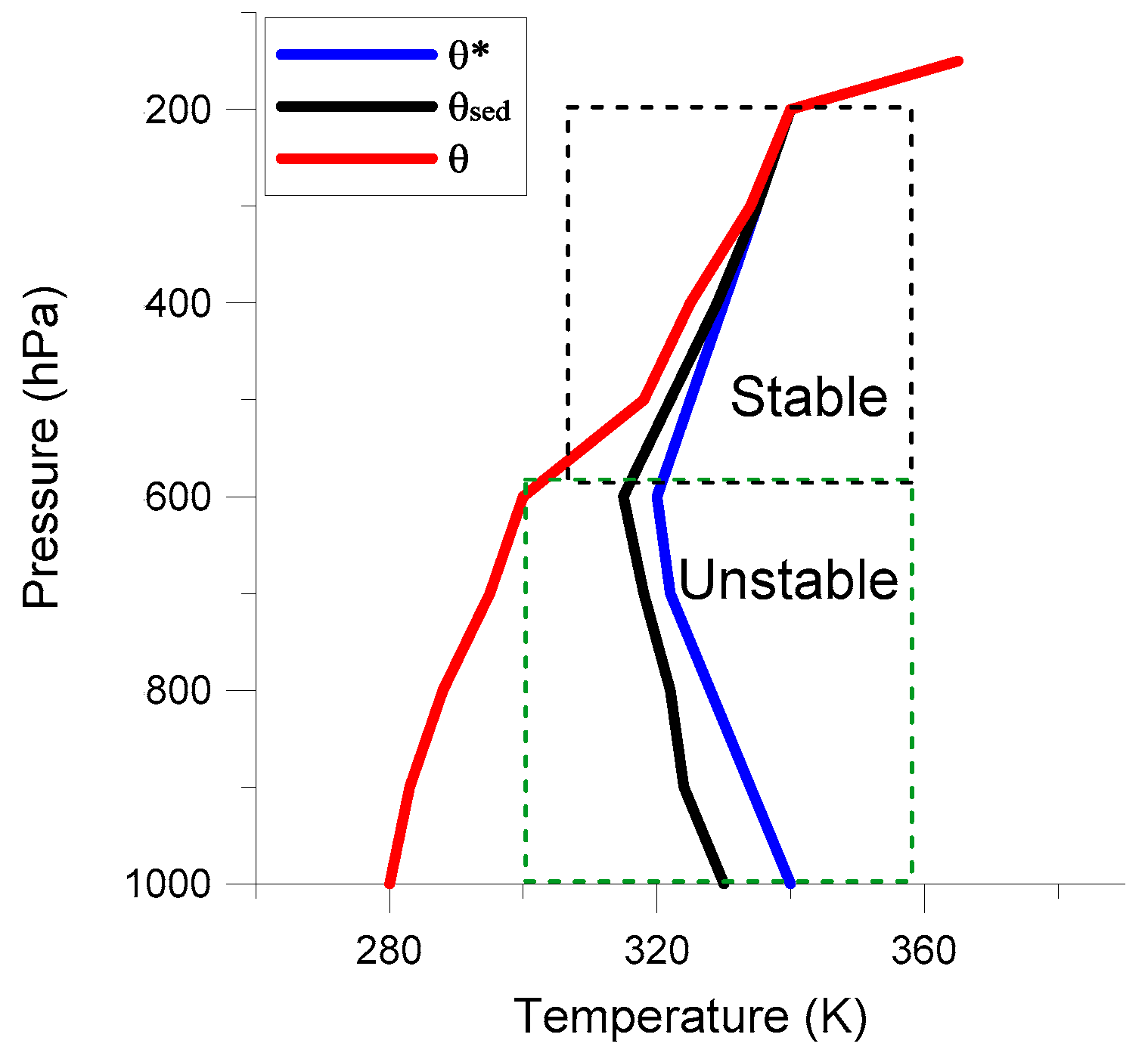
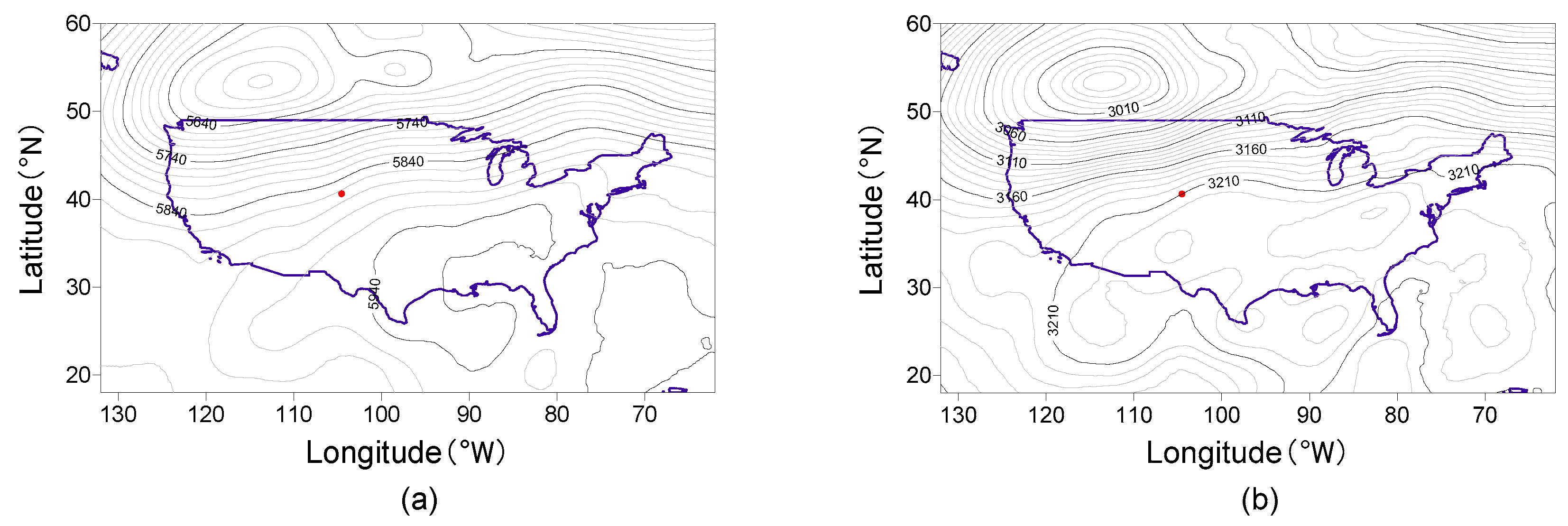


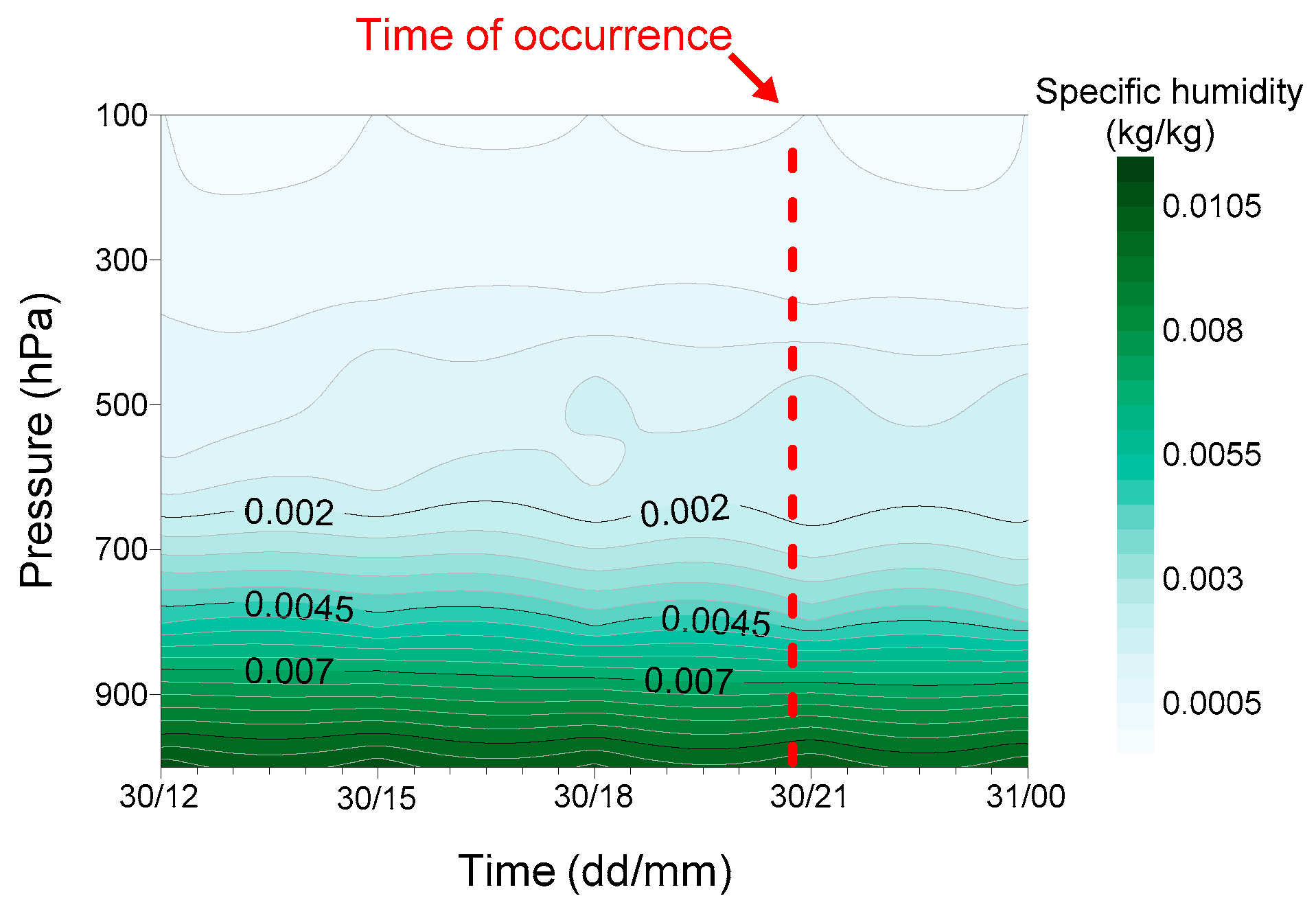
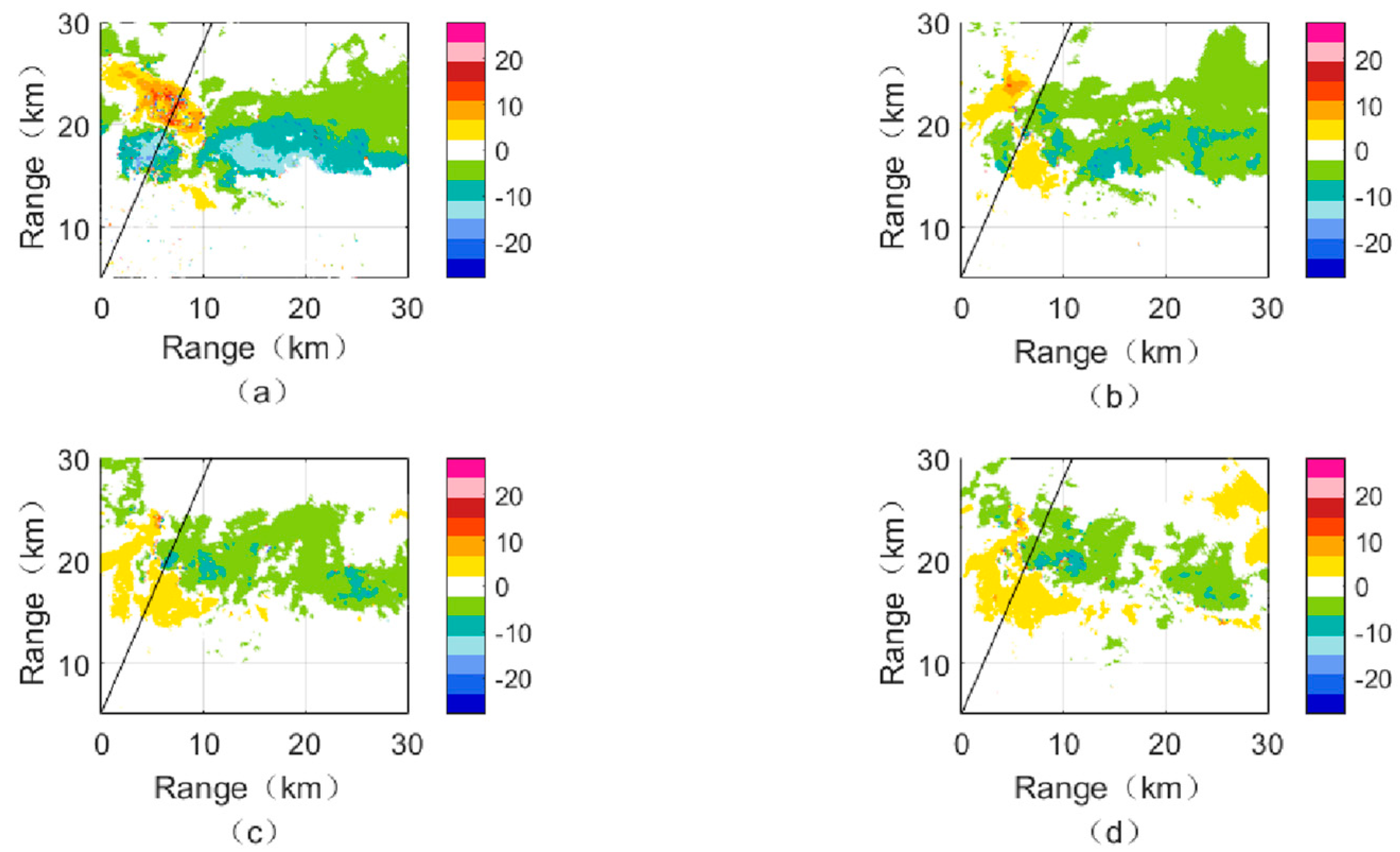
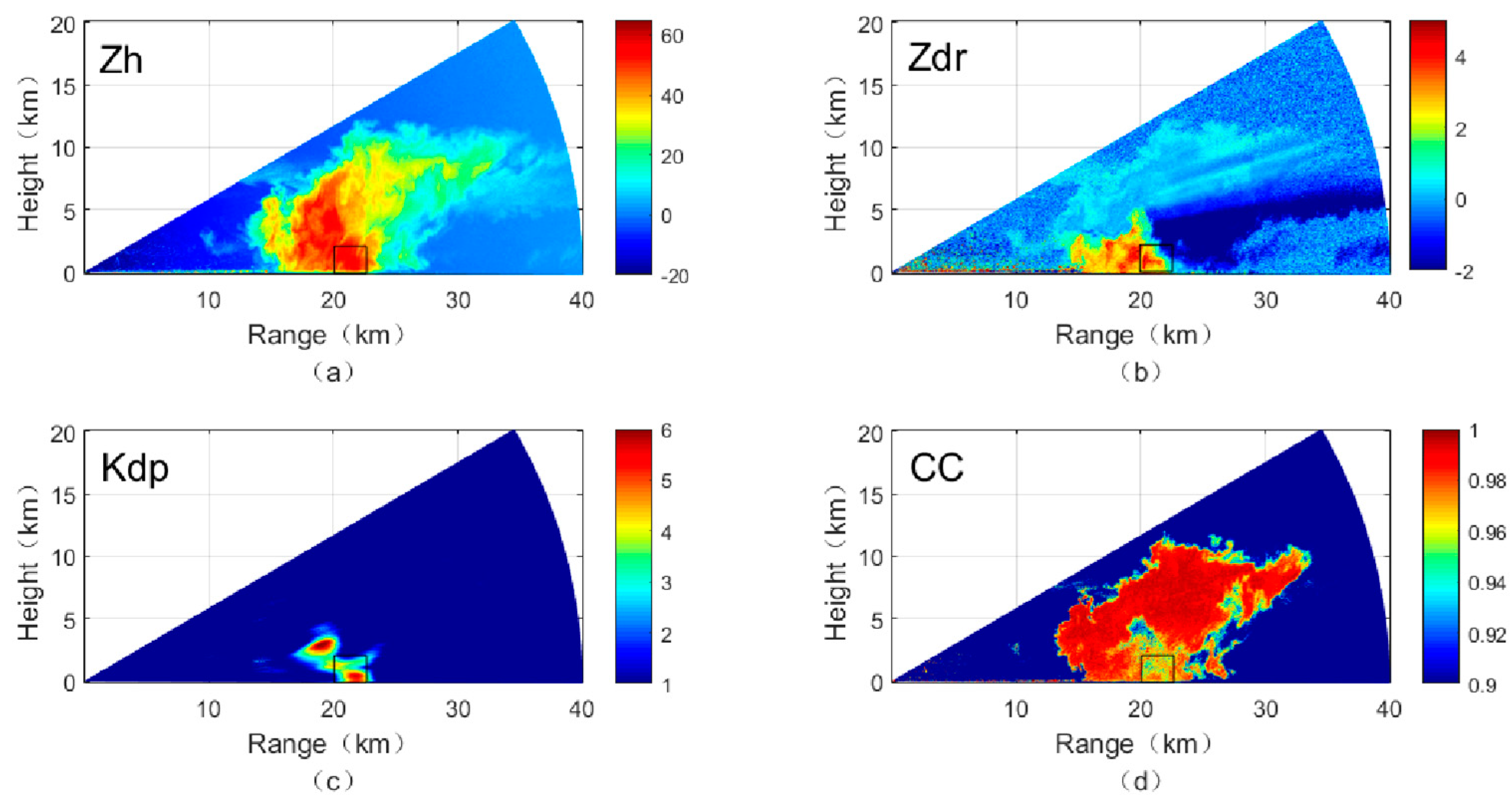
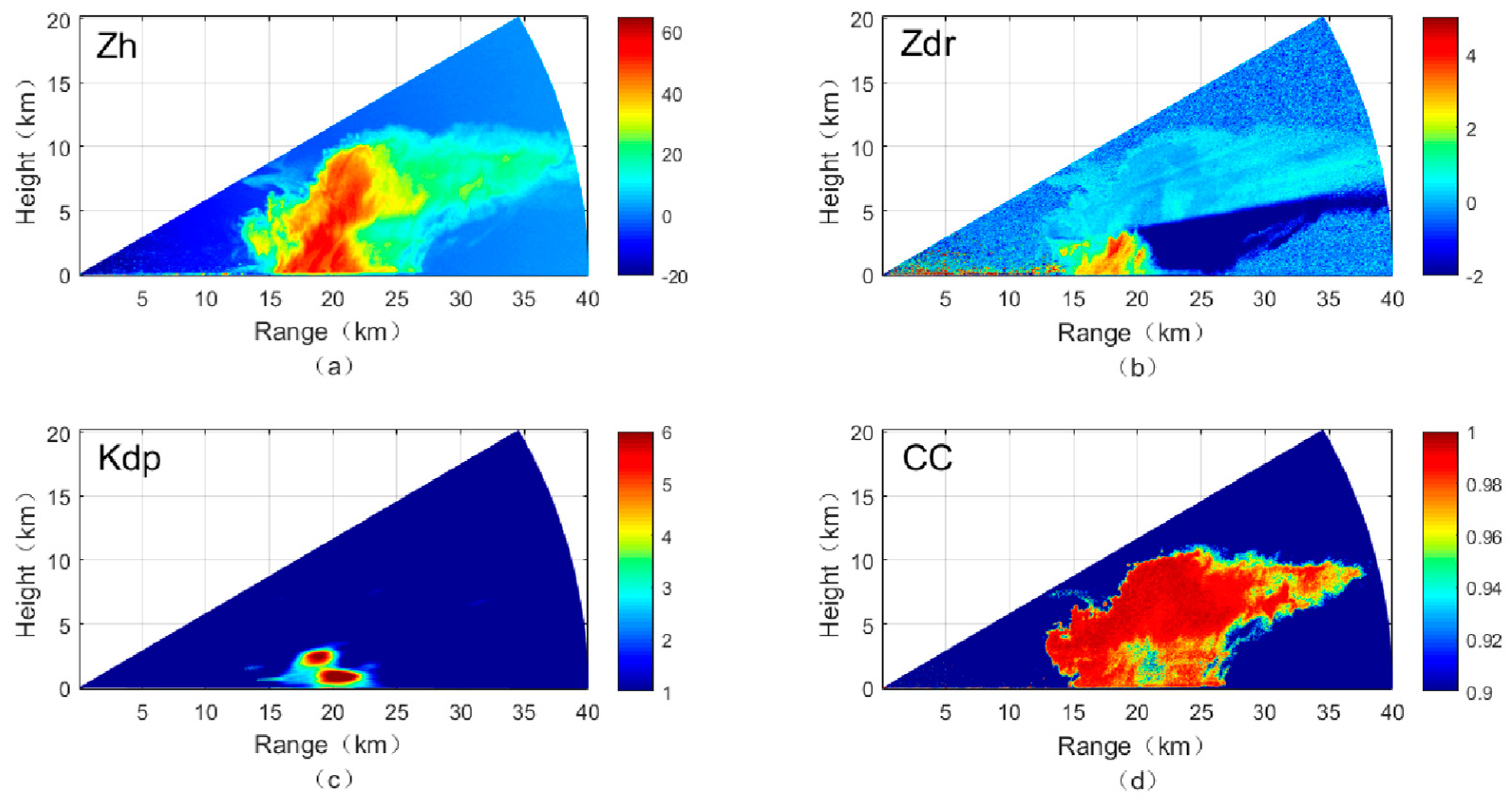
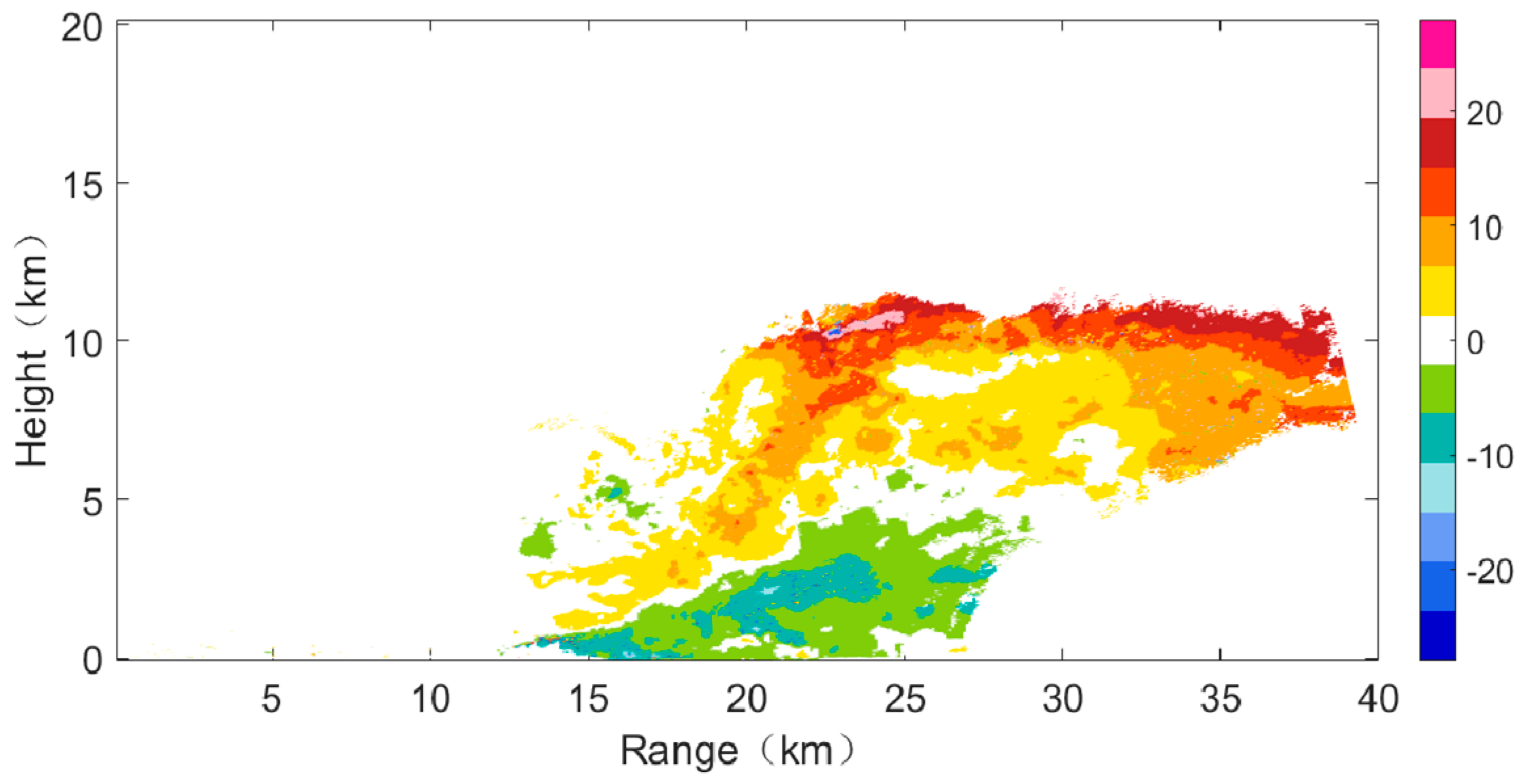

| Gain | 53 dBi |
|---|---|
| Beamwidth | 0.3° |
| Sidelobe level | <36 dB |
| Frequency | 9.41 GHz ± 30 MHz |
| PRF max | 2.00 kHz |
| Sensitivity (dual-wavelength mode) | −15 dBz, 10 km |
| Range sampling | 1.5–192.0 m |
| Dynamic range | 90 dB |
| Scan type | PPI (360°, sector), RHI, fixed pointing, vertically pointing |
© 2018 by the authors. Licensee MDPI, Basel, Switzerland. This article is an open access article distributed under the terms and conditions of the Creative Commons Attribution (CC BY) license (http://creativecommons.org/licenses/by/4.0/).
Share and Cite
Wang, H.; Chandrasekar, V.; He, J.; Shi, Z.; Wang, L. Characteristic Analysis of the Downburst in Greely, Colorado on 30 July 2017 Using WPEA Method and X-Band Radar Observations. Atmosphere 2018, 9, 348. https://doi.org/10.3390/atmos9090348
Wang H, Chandrasekar V, He J, Shi Z, Wang L. Characteristic Analysis of the Downburst in Greely, Colorado on 30 July 2017 Using WPEA Method and X-Band Radar Observations. Atmosphere. 2018; 9(9):348. https://doi.org/10.3390/atmos9090348
Chicago/Turabian StyleWang, Hao, Venkatachalam Chandrasekar, Jianxin He, Zhao Shi, and Lijuan Wang. 2018. "Characteristic Analysis of the Downburst in Greely, Colorado on 30 July 2017 Using WPEA Method and X-Band Radar Observations" Atmosphere 9, no. 9: 348. https://doi.org/10.3390/atmos9090348






